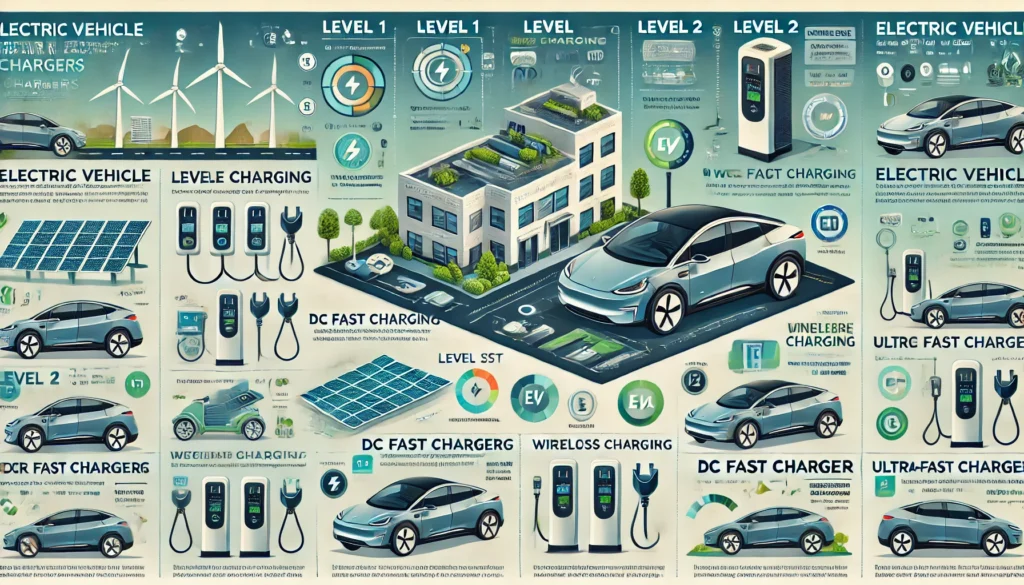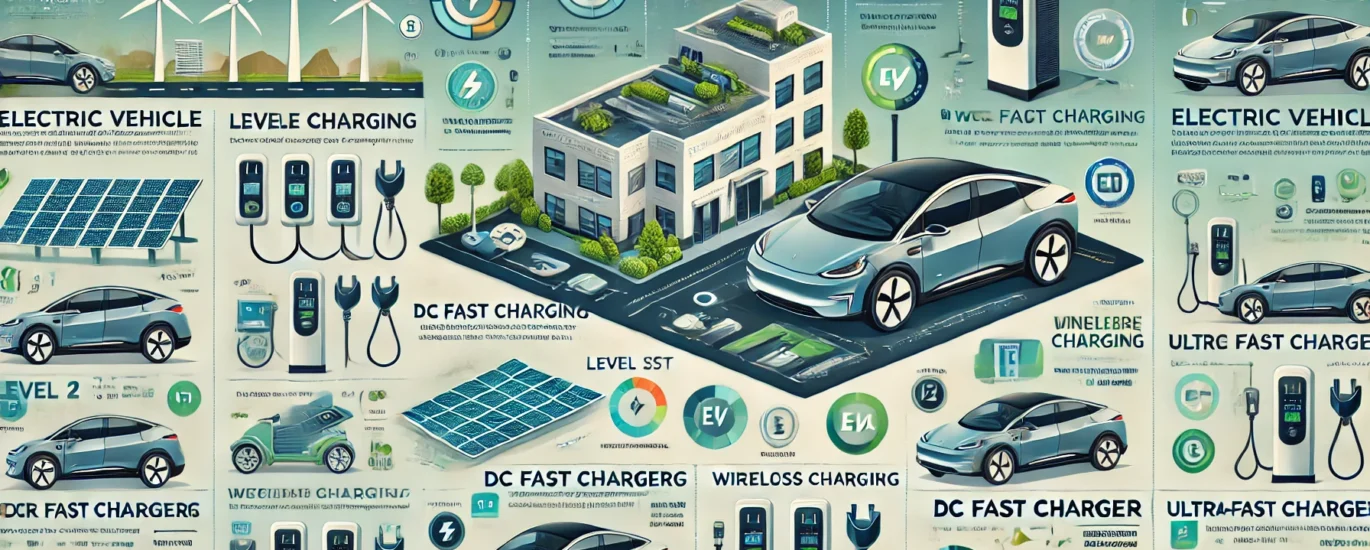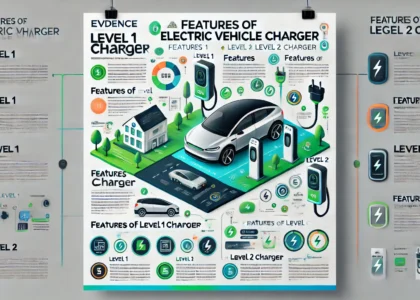The utilization of electric vehicles continues to rise, and electric vehicle drivers, manufacturer companies, and lawmakers need to be familiar with electrical vehicle chargers. There are many kinds of electrical vehicle chargers each designed for a particular combination of conditions and needs of the users. Comfort, expenses, and effectiveness are all possible to be greatly affected by the decision you make.

EV charger types and their applications
- Chargers at level 1
Energy result: it is up to 2kW at a voltage of 120.
Rate of charging: three to five miles per hour
Applications:
It is suitable for plugging hybrid electric cars at home. Excellent for recharging overnight when vehicles have been parked for a lengthy period.
Advantages:
Cost-effective and acceptable for most home connections. There are no additional installation fees. It is perfect for drivers with twenty to fifty-mile regular daily trips.
- Chargers at level 2
240 volts of electricity is the maximum capacity.
Rate of charging: ten to sixty miles per hour
Utilization:
Frequently found in public places, workplaces, and households
Reliable for faster charging demands.
Advantages:
It is quicker than level 1 battery chargers and has sufficient versatility to be employed for noon battery charges. Supports every type of electric vehicle, particularly those having a lengthy range. Electrical vehicle owners are attempting to achieve a balance between the charging cost and speed.
- Fast chargers for direct current
Output power: fifty to three fifty kWh.
Rate of charging: usual travel distance of sixty to eighty miles in just twenty minutes.
Applications:
It is designed for metropolitan groups, campgrounds, and highway connectors. It is ideal for extended drives or scenarios needing lightning-fast charging.
Advantages:
Waiting intervals are minimized with faster charging.
It enables journeys across the country by covering the gap in taking charge.
It is suitable for Long-distance travelers and electrical vehicle charging networks.
- Extremely fast chargers
Output energy: three fifty-plus Kw.
Based on the electric vehicle model charging may travel as far as 300 miles in just fifteen minutes.
Uses: the novel technology aims for luxurious electric vehicles with large battery storage. It is ideal for roadway infrastructure.
Advantages:
Unmatched speed, substantially reducing charging times, encourages the most recent electric vehicles with innovative energy management technological advancements. Install electric vehicles and infrastructure for charging at major transportation points.
- Wireless Chargers
3.6 to eleven kW of electricity generated.
Similar to level 2 charger devices about the speed of changing.
Applications:
Vehicles, commercial lots, and spots to park for houses. Makes payment for autonomous vehicles simpler.
Benefits:
Charging is simple and practical because no wiring or cables are needed. Reduces connection wear straining. It is suitable for users who seek connections with intelligent home systems and comfort.
Common questions of users
- Are DC quick chargers suitable for all-electric vehicles?
Rapid charging is not permitted by every electric vehicle; accessibility depends upon:
- The car’s capability to power itself on the outside.
- The connection type (CCS, or Tesla)
For better connectivity and compatibility, companies are establishing common interfaces.
- How one should pick the most effective charger for user needs?
- Driving routines: quicker alternatives are beneficial for high mileage driver.
- Public chargers are easy to use, whereas home battery charges are less costly.
- Cost: although level 1 and level 2 batteries are affordable, DC fast charging devices are the excellent choice for long travel.
Specification and ports for charging
According to the charging device and local regulations, the electric vehicle sector employs an array of connection types.
Type 1 charger: commonly used for level 1 and level 2 charges in North America.
Type 2 charger: both alternating and direct current charging are mutually beneficial, and commonly used in Europe.
The combined charging system has grown progressively more popular around the world and enables both direct and alternating current.
CHAdeMO: it enables bidirectional charging and is Japan’s standard DC charger.
Recent advances in electrical vehicle charging technologies
- Variable charging
Using electric roadways, this sort of technology enables vehicles to power up while actually they are traveling or moving. Dynamic battery life although currently in its experimental phase, has the chance for doing with regular pauses.
- Bidirectional recharging
During times of high usage electrical vehicles may transmit the energy to the electrical grid using V2G systems or vehicle-to-grid systems.
- Units for changing the batteries
Operators may substitute an empty battery with one that is fully charged instead of waiting for it to charge. This type of system has grown increasingly common in countries including China, where it’s not being commonly utilized.
- Connectors powered by sunlight charge
Chargers may operate separately from the network, due to incorporated solar power plants and battery storage gadgets, that reduce greenhouse gases while generating the power in remote regions.
Cost implication for different electrical vehicle charger setup rates
- Installation expense
Level 1: these chargers use conventional outlets; there are no installation charges.
Level 2: five hundred dollars to two thousand dollars, depending on workers and supplies
Direct current fast chargers: they are suitable for public usage, ranging between fifty thousand dollars to one hundred thousand dollars.
- Logistics expense
The median price of charging at home ranges from 0.05 dollars to 0.15 per kWh, based on regional rates of electricity. Public rapid chargers vary in cost between 0.20 dollars to 0.50 dollars per kWh with ultra-fast version paying extra.
Ways to lower the total price of charging
- for regular outdoor charging use the subscription packages.
- To cover the electricity expenditures, install solar power plants for private charging.
- Make the most of off-peak times energy hours.
The ending words
With wide range of options for every need of user at residence, at office, and in open area, electric vehicle charger technology is impacting the course of accessibility in the years to come. The process of charging the vehicles is increasingly accessible, productive, and profitable, with choices that range from level 1 chargers fro night comfort to extremely fast and wireless communication system for versatility on the opportunity. A more effective, electric future will be assured by advancements in clean energy integration and cost challenges.


